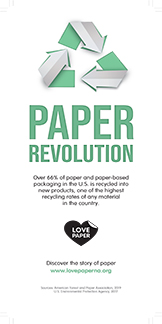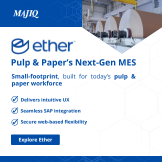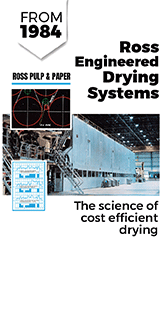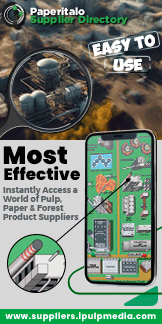Those of us in the industry know how sustainable our materials and substrates are that we produce. Forest growth happens naturally while removing carbon dioxide from the atmosphere. Paper-based products bio-degrade readily. Paper-based products are quite easy to recycle once collected and sorted. The public is not fully aware how natural and organic our industry really is due to intense environmental lobbies and propaganda. In fact, I remember a time not too long ago that people declared "plastic over paper" in the grocery store. I must admit, I generally chose plastic because I could carry more groceries in one hand and then re-use bags for my dog's bio-waste in the back yard or on our walks. In response, handles soon appeared on paper grocery bags, which is a great improvement, but that didn't solve my storage and re-use habits. Ironically, when I was a kid, we used our paper grocery bags brought home from the store for schoolbook covers, taking out stacks of old newsprint that accumulated daily, and emptying our ashes from the fireplace. None of those needs exist anymore. Good times.
Deforestation was another battle cry from the environmental lobby. You're killing trees! You evil capitalist! For those of us in the know...how non-sensical is that? Industries that rely on a steady, large-volume source of uniform raw materials tend to secure their own supply by owning/planting/harvesting their own forests. Managed forests - like farmers - require a tremendous amount of planning and patience. In fact, when trees grow at 10% a year - that's a pretty good investment over the long haul (doubling your value every 7.2 years.) Some tree species can grow back several times from stumps after harvesting! Sure, there is some loss with fires, infestations, yield loss, etc. but you get the point. Old growth or the Amazon rainforest is not where we play - at least in this part of the world.
Where I see a great argument on sustainability is the energy intensity required to dry our paper to useful targets. Sure, gravity, centrifugal force, and mechanical pressure do a lot of dewatering in our process, but that last bit of drying is tough. In the case of integrated mill sites, we generate our energy from of all those wonderful BTUs hidden inside that organic waste stream of lignin and other components removed in the pulping process. Thank you, recovery boiler. I don't know the accurate material and energy balance on this, but I would guess virgin grades in aggregate across the globe might be a carbon sink for our planet. According to current climate orthodoxy, that's a good thing.
The tides are quickly turning. Now everyone is seeking paper solutions for protecting and transporting their products to the end user. The EU mandated the removal of single-use plastics (i.e. plastic packaging.) We'll probably see something like this in the not-too-distant future here in the US. Paper films are all the rage, as is formable paper that presents itself like plastic, and now even liquid bottles to replace glass. The innovation process is going strong to meet these new requirements from the public, who influence the brand owners that make packaging decisions. That should be great news for the younger readers entering the industry.
When I was in undergrad, and for several years after graduation, I was intimately involved in every kind of paper grade production asset. We made great paper as efficiently as possible. That was the goal of everyone involved. However, we were not really in touch with how it all got processed and consumed on the other side of the roll storage wall. Sure, we read our books, blew our noses, opened many cereal boxes, printed our term papers, etc. as a consumer. We were out of touch with the converting processes. My career has taken me from the production floor into the amazing world of converting and end use. Not only is it eye opening to why property specs are what they are, it makes your heart sink seeing the waste generated converting a 12-pack case into a 6 pack case millions of times.
Our raw material supply, production processes, high recycling rates, and bio-degradability - if paper reaches the garbage dump - really is sustainable and environmentally responsible. Yet, there's some serious work to be done downstream to further improve the optics around sustainability. Generally, our products will have to be lighter, stronger, softer, more resilient depending on the end use. Sometimes that will even mean less MSF produced and consumed. Consider the Apple iPhone box after the iPhone 12 launch, which did not include a wall adapter. The retail box was half the size of all the models that came before it. Yes, there's less material needed for the box, and therefore less waste after purchase. Now consider it takes half the number of airplanes to distribute those iPhones to different regions of the world. Half as many trucks to get them to retailers. And from Apple's perspective, they don't have to regionalize finished goods with different types of wall adaptors. Kudos to Apple for making that decision. Someone got an award for not only saving the planet, but probably for the hundreds of millions of dollars saved in packaging, transportation, warehousing, and demand planning year after year.
I think there will be much more publicity for our industry the further down this sustainability path we go, but it's going to take some serious coordination among many constituents along the whole supply chain. Like the case for paper grocery bags, it will be up to us, the human population, on how we decide to use, reuse and recycle our products to have a material impact on wasting finite resources like water and energy. We have the smartest, most practical people in our industry, and affiliates, so we will evolve when the incentives are right. Wherever we're headed, I still prefer some good ol' fashioned paper towels in public bathrooms rather than using hand dryers though. Who's got time for that?
Steve Sena (stevesena@me.com) is a Cincinnati native. He obtained degrees in Paper Science & Engineering from Miami University in Oxford, OH and an MBA concentrating in Economics from Xavier University. He's worked for a broad array of leading producers, suppliers, and converters of pulp and paper grades.






















